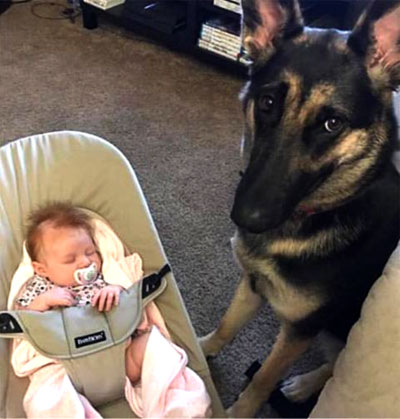
Preparing for a new baby
No matter how much you plan ahead, the addition of a new family member may be difficult for your pet. Remember, your dog or cat was your first “baby” and is used to being the center of your attention. So it’s understandable that he may experience something akin to sibling rivalry when you introduce a new human baby into your household.
You can minimize this feeling by working with him before you bring home your baby. For example, because your new baby will demand a lot of your time and energy, gradually accustom your pet to spending less time with you.
Drastically decreasing attention and frequently scolding, ignoring, or isolating your pet after the baby comes home will likely make your pet feel stressed.
If your pet is particularly attached to the mother-to-be, another family member should develop a closer relationship with the animal. That way, the pet can still feel loved and provided for while mom is busy with the baby.
How can I prepare my pet?
Below are several suggestions to make introducing your pet and baby safer and smoother for all. Be sure to carry out these changes months before the baby’s arrival to best prepare your pet.
- Take your pet to the veterinarian for a routine health exam and necessary vaccinations.
- Address any pet training and behavior problems. If your pet exhibits fear and anxiety, now is the time to get help from an animal behavior specialist.
- If your pet’s behavior includes gentle nibbling, pouncing, or swatting at you and others, redirect that behavior to appropriate objects.
- Get your pet used to nail trims.
- Train your pet to remain calmly on the floor beside you until you invite him on your lap, which will soon cradle a newborn.
- Consider enrolling in a training class with your dog, and practice training techniques. Training allows you to safely and humanely control your dog’s behavior and enhances the bond between you and your pet.
- Encourage friends with infants to visit your home to accustom your pet to babies. Supervise all pet and infant interactions.
- Accustom your pet to baby-related noises months before the baby is expected. For example, play recordings of a baby crying, turn on the mechanical infant swing, and use the rocking chair. Make these positive experiences for your pet by offering a treat or playtime.
- To discourage your pet from jumping on the baby’s crib and changing table, apply double-stick tape to the furniture.
- If the baby’s room will be off-limits to your pet, install a sturdy barrier such as a removable gate (available at pet or baby supply stores) or, for jumpers, even a screen door. Because these barriers still allow your pet to see and hear what’s happening in the room, he’ll feel less isolated from the family and more comfortable with the new baby noises.
- Use a baby doll to help your pet get used to the real thing. Carry around a swaddled baby doll, take the doll in the stroller when you walk your dog, and use the doll to get your pet used to routine baby activities, such as bathing and diaper changing.
- Talk to your pet about the baby, using the baby’s name if you’ve selected one.
- Sprinkle baby powder or baby oil on your skin so your pet becomes familiar with the new smells.
- Finally, plan ahead to make sure your pet gets proper care while you’re at the birthing center.
What Do We Do After Baby Is Born?
Welcoming a new baby is exciting for your family. Remember when you first brought home your dog or cat? But before you bring your baby home from the hospital, have your partner or friend take home something with the baby’s scent (such as a blanket) for your pet to investigate.
When you return from the hospital, your pet may be eager to greet you and receive your attention. Have someone else take the baby into another room while you give your pet a warm, but calm, welcome. Keep some treats handy so you can distract your pet.
After the initial greeting, you can bring your pet with you to sit next to the baby; reward your pet with treats for appropriate behavior. Remember, you want your pet to view associating with the baby as a positive experience. To prevent anxiety or injury, never force your pet to get near the baby, and always supervise any interaction.
Life will no doubt be hectic caring for your new baby, but try to maintain regular routines as much as possible to help your pet adjust. And be sure to spend one-on-one quality time with your pet each day—it may help relax you, too. With proper training, supervision, and adjustments, you, your new baby, and your pet should be able to live together safely and happily as one (now larger) family.
